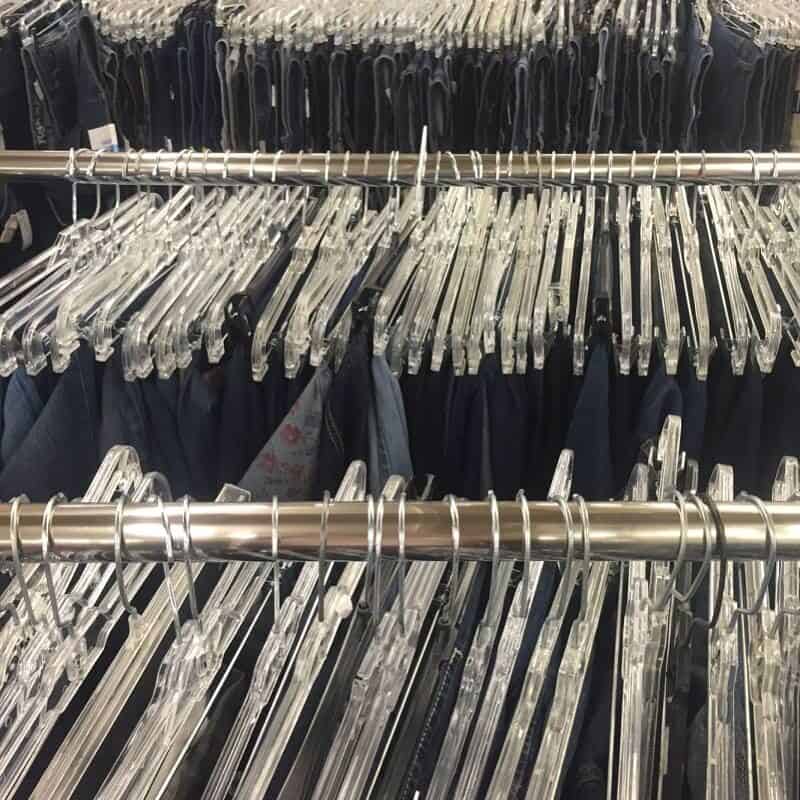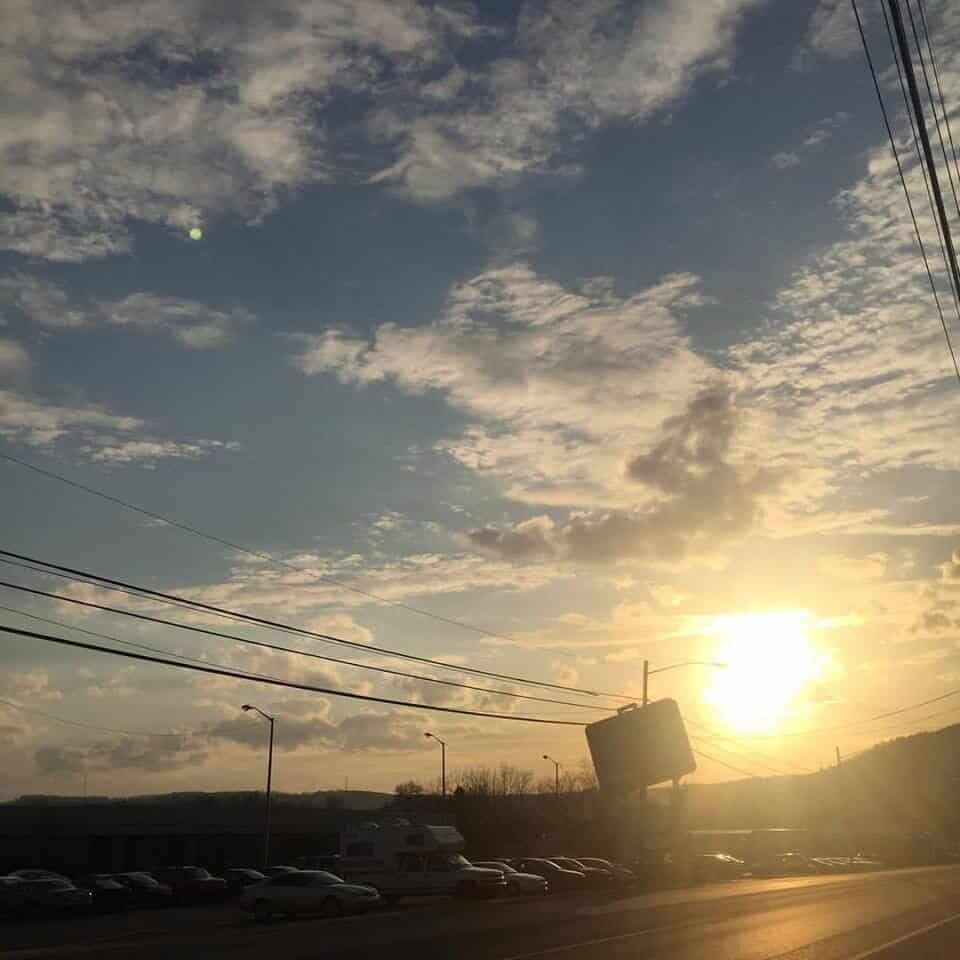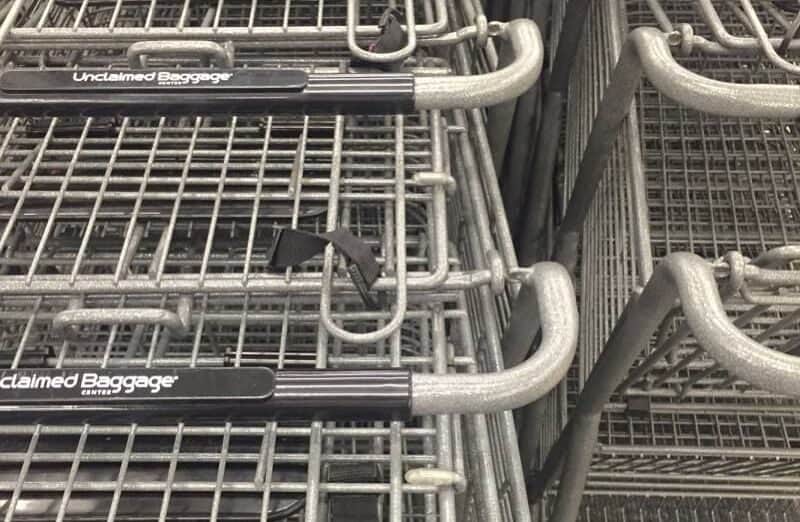I pull into the parking lot of the Unclaimed Baggage Center on a gray afternoon befitting a temple of lost things. Lost things come to Scottsboro, Alabama. Well, not all lost things, but lost things in lost luggage.
But I am not lost. I have driven through mountains, by fireworks megastores (each one always the “last” and “biggest”), past dead dogs rotting on the side of the road, to Scottsboro, and one of Alabama’s top tourist attractions. The Unclaimed Baggage Center itself looks like a standard office park, apart from the blue and orange sign shaped like a suitcase—its walls are lined with neatly trimmed hedges, and two American flags frame the entrance. A glider, several rocking chairs, and hanging planters suggest the front porch of a house rather than a business.
When I traveled to Montreal several years ago, my suitcase didn’t arrive. It is a strange feeling to walk out of an airport without a bag. Without our luggage, we’re set loose in the world unprepared. Passing under signs in French, I felt more than empty-handed: I felt dangerously light, as if I didn’t belong where I was. The next day, I went shopping and bought a black sweater and black slacks—I might have been in mourning for my suitcase, which was delivered to my hotel the next day.
We take for granted that we get to keep our luggage with us when we travel. It may be taken away from us for periods of time, but it does not generally travel separately from us, as in the past. The transport of luggage used to function more like the mailing of a package. And like a package, trunks were banged about a bit, sometimes causing their contents to be damaged.
“Would you believe it my trunk is come already; and, what completes the wondrous happiness, nothing is damaged,” wrote Jane Austen, in a letter in 1808. The humorous hyperbole of “wondrous happiness” is classic Austen, but it also hints at the very real anxiety. It is wondrous that her possessions are not damaged, and she is relieved. In 1814, she was not so lucky: “My Trunk did not come last night, I suppose it will this morning; if not I must borrow Stockings & buy Shoes & Gloves for my visit. I was foolish not to provide better against such a Possibility. I have great hope however that writing about it in this way, will bring the Trunk presently.” Here, she jokes that she might conjure the trunk into existence by writing, thus remedying the problem of her self-proclaimed foolishness.
Austen got her things back. When someone doesn’t, their things go to the Unclaimed Baggage Center, and the shoppers who flock there. The 40,000-square-foot center opened in 1970 and annually draws over eight hundred thousand visitors, from over forty countries. Its status as a major attraction is underscored by a display of tourist brochures at the entrance for local vineyards, zoos, skydiving, golfing, caverns, state parks, and the North Alabama Hallelujah Trail of Sacred Places. You can buy souvenir T-shirts. The departments in the main store include jewelry, sporting goods, formalwear, books, electronics (“Purchase Limit 3 Laptops Per Guest Per Day”), men’s and women’s clothing, and (of course) luggage. There is a Starbucks. A separate building—the “Etc.” store—houses children’s items and housewares.
When I arrive, the parking lot is halfway full, and several campers testify to the store’s status as a vacation destination. A sign off to the side of the building indicates that there is more RV parking out back. Next door is Alabama Tires and a Citgo. Across the street is a T and W Unclaimed Baggage, which looks rather run-down in comparison. (One Unclaimed Baggage employee describes it as “a knock-off.”) Behind the center is Cedar Hill Cemetery, where, according to their website, twenty of the city’s sixty-three acres are available at $400 per grave or four grave plots for $1,400. There are graves from the Civil War and the graves of some of the city’s first families. And dogwood trees.
The center receives bags from airlines, bus lines, Amtrak, cruise ships, rental car companies, and resorts. The center also sells unclaimed cargo. But airline travel accounts for the majority of the bags. According to the website, 99.5 percent of bags are picked up at baggage claim. But then there is the other 0.5 percent. In 2012, over 1.8 million bags were lost, stolen, or damaged by major US airlines on domestic flights. This means that slightly over three bags were mishandled per 1,000 passengers. Regional and budget airlines tend to have the worst track records. According to the website of the Unclaimed Baggage Center, airlines conduct “an extensive three-month tracing process” to try to find the unclaimed bags’ owners, and claims are paid on the bags that can’t be found. Then they sell the “unclaimed baggage property”—now no longer the property of anyone—to the center.

The center’s website describes these bags as “orphaned.” The word suggests that a bag’s owner is its parent, and that this parent has died. The terms “lost” and “unclaimed” are used interchangeably, but “lost” implies that the bag was misplaced, as you might lose your keys, while “unclaimed” implies that it has been been abandoned. This abandonment is related to its status as lost, but its status as lost can’t entirely account for it.
These orphaned bags are bought sight-unseen and arrive by the tractor-trailer load at the center’s processing facility, where they are opened, sorted, and priced. Over seven thousand new items arrive every day. Clothing is laundered at an in-house facility, the largest in northern Alabama. Electronics are tested and wiped of personal data. Fine jewelry is cleaned and appraised. Bags are opened at 2:30 pm, Mondays through Saturdays, for the public, so you can peer into a stranger’s suitcase before everything is removed. The staff sorts out “the best items” for retail, and approximately half of the remaining items are donated through their Reclaimed for Good program. The other half, “unsuitable for retail or donation,” are thrown away.
This process is represented on the website by an image of an open suitcase; its contents are divided into the three categories of SELL, DONATE, and TRASH lower down on the page. The category of “trash” includes a pacifier, a Sharpie, paper clips, a rubber band, a tube of toothpaste and a toothbrush, a small brown Field Notes notebook, and a folded piece of paper that appears to be a receipt. That one-quarter of this lost property is worthless strikes me as outrageously sad. You can’t do much with someone else’s toothbrush. Or with her notebook.
But these bags also contain odd and extraordinary things. The entrance to the center is designated as a “museum” of found objects, presided over by a portrait of founders Doyle and Sue Owens. Sue is seated in a yellow armchair and Doyle stands above her, with his hand on her shoulder. To the right is a display of “Religious Objects,” and to the left the puppet goblin Hoggle from the 1986 film Labyrinth, who arrived at the center in 1997 in “deteriorating condition” and was restored. These displays continue in the store itself, where particular treasures are mounted high on the walls: moose antlers, Underwood typewriters, and musical instruments, including a Russian Domra and an Afghan Rubab.
These objects are accompanied by signs that identify and describe them. A “Handmade Ship Model, HMS Surprise” includes a brief history of the Napoleonic Wars and a picture of Russell Crowe in the film Master and Commander. An “Antique Flirting Fan” from 2010 is assigned a story: “This beautifully hand-painted fan from the 1800s shows classical scenes of youths at their leisure. Gilded in gold with intricately carved bone sticks, this Victorian fan must have belonged to a lady of significant social standing.” These objects are not for sale.
I stand by the rows of pale gray shopping carts and look at my map. Rows of jeans stretch out in front of me, folded in half and hung on clip hangers. I walk through the section for uniforms, past of a vat of lace-trimmed leg warmers (a shopper has abandoned a motel-room-style black pleather Holy Bible among these garments), and into the formalwear room, which is filled with long, brightly-colored dresses that bring to mind prom in the ‘90s. Mass-produced wedding dresses—David’s Bridal sort of stuff—are hung six deep against the wall, all sequins, lace, and taffeta. I wonder if they have been worn. I wander past racks of button-down shirts, robes, and pajamas. Some of the store’s most expensive items—an ivory lace Chloé dress, size 12 ($849.99; Retails $3,195.00) and a “Sherazade Trunk” by the Barrel Shack ($189.99; Retails: $1,450.00)—are singled out and arranged on top of the racks, set apart from a sea of everyday things as reminders of the treasures lurking. One woman looks up at the Chloé dress.
“How could someone not claim a Chloé dress?” she asks her friend, shaking her head. “Amazing.”
The vast majority of items are ordinary. Costume jewelry. Blouses, dresses, T-shirts. Rows of point-and-shoot cameras and mass-market paperbacks. The things of everyday life. But the tension between the ordinary and the extraordinary—not far from the café is an intricately carved dark wood frame labeled “Nineteenth-Century Swiss Black Forest $1350.00”—gives the center its character. In fine jewelry, the cases are filled with bangle bracelets, watches, pearl necklaces, cameo brooches and pendants, gold crosses encrusted with diamonds, and gold and silver chains of all lengths. I survey the price tags, which are strangely precise: $103.99, $66.99, $172.99, $260.99, $500.99.
A man next to me asks the saleswoman if he can see a cameo ring, and she takes it out of the case and hands it to him.
“This one is really pretty,” she says. “We had another one like this that was a real bargain. It got snapped up.”
He looks at it carefully and turns it over. “Yes, that’s real nice.”
“It’s a beauty. And there’s this other one with the pearl, which has a really unique setting.”
She hands him the other ring, which he slips on the end of his finger, as far as it will go, as if contemplating what it would look like on a woman’s hand.
“Hmm,” he says. “This one is a find.”
I walk over to the scarf section. Another saleswoman notices my ring—a skull—and smiles.
“Do you like skulls?” she asks.
“I do,” I say.
“Well, I have something to show you that just came in.” She walks away for a moment and returns holding a neatly folded black-and-white skull scarf.
“Alexander McQueen,” she says.
“Ooh. That’s lovely.”
“It just came in.”
“There are some beautiful things here, too,” I say, gesturing at the scarves in the case.
“Yes,” she says. “Hermès.”
One of the scarves is a deep blue, and I ask to see it. She takes it out and places it on the counter. I unfold it; the pattern is an angel.
I think of the suitcase that held this scarf. Maybe it was locked. Or maybe it wasn’t. Maybe it doesn’t matter. Suitcase locks have never struck me as a legitimate form of security. Perhaps it is their size: little metal things with a keyhole or combination locks with tiny buttons. They bring to mind the lock on your childhood diary: more symbolic than anything, more about proclaiming that something should not be opened rather than actually preventing it. And now the scarf is here, orphaned. I decide to buy it, and the saleswoman smiles approvingly.
The scarf is a splurge, but I don’t regret it. Now its value is determined by the market, not by sentiment or memory. When this scarf was taken out of its suitcase, its connection to its owner was lost. The suitcases that enclose these things also define them, and the things mean less, or differently, apart.

Before I leave, I walk out behind the building to the cemetery and stand under the iron archway, watching people come and go from their cars, their shopping bags in hand. The great question of the Unclaimed Baggage Center is why the bags remain unclaimed. When I told people I was coming here, that is what they always asked: Why wouldn’t you claim your bag? Perhaps there is no answer to this question. Or the answer is that it is unanswered, unanswerable. The things at vintage stores or antiques malls have been brought there—sold or donated or found by the stores’ owners. Maybe the objects’ former owners died. Maybe their former owners moved and were getting rid of things. But Unclaimed Baggage is different. Perhaps it is not that the objects are lost, but that their owners are. These people hover over the center like ghosts, and no one knows what to say about them.
My scarf is folded in a white paper bag, the top stapled shut with the receipt. I take it out. It is soft. It doesn’t feel new; it feels like something that belonged to someone. I hold it up and look at it. The angel’s expression is inscrutable, almost childlike, her green wings resting behind her, her head crowned with flowers. She wears a cape that is parted and falls at her sides, but she doesn’t really have sides as she has no body. Inside the cape, in place of a torso, is a void. Nothing. Only a geometric pattern like broken glass. She flaps in the breeze, and I think she is the angel of unclaimed bags, taking everything into her nothingness.
I tie the scarf around my head to keep my hair out of my eyes while I drive home.
A version of this essay appears in Luggage, part of the Bloomsbury series “Object Lessons.”
